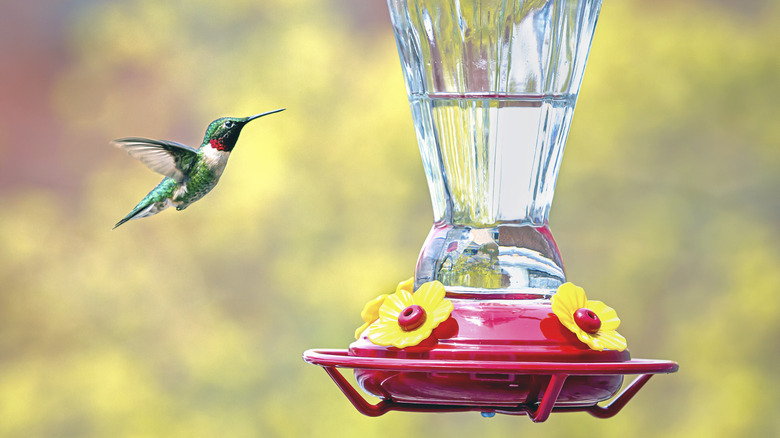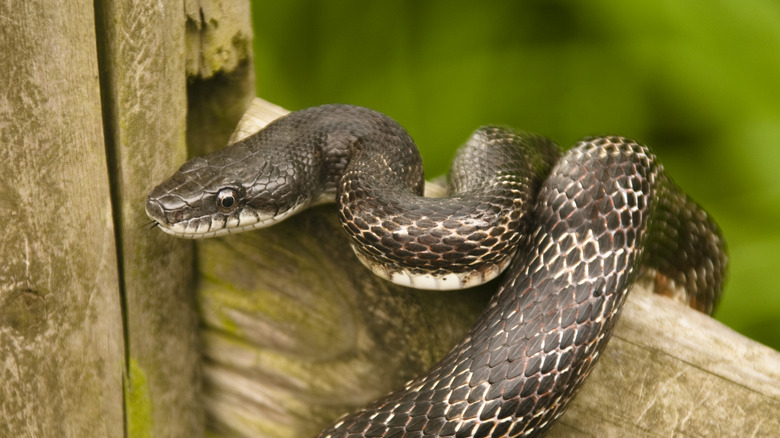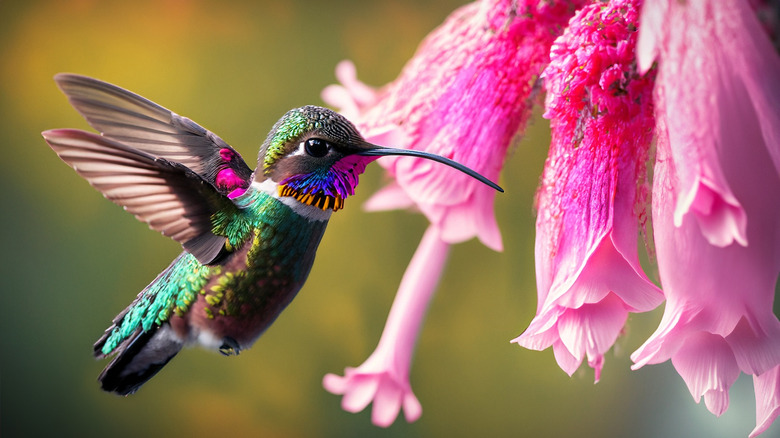The Slithering Foe You Should Keep Far Away From Hummingbird Feeders
Hummingbirds, known for being one of the smallest types of birds in the world, are fascinating to watch as they hover near feeders and buzz around with their brightly colored feathers. But don't let their small size fool you, as hummingbirds can have feisty personalities that make them territorial and aggressive with others. However, if you have hummingbird feeders in your yard, other birds aren't the only concern to have regarding their safety. Snakes, particularly types of rat snakes, are common predators for hummingbirds due to their carnivorous diet and surprisingly agile climbing abilities. Their rough and rigid scales help them grip while climbing and make it easy for these slithering foes to make their way up many types of bird feeders. Combine this with the fact that hummingbirds stop to eat nearly every 10 minutes; it's clear their repeated feeding sessions put them at risk for predator attacks.
There are roughly 50 species of rat snakes found across the globe, but thankfully, these large constrictors are generally docile creatures unless threatened. One major offender of feeder attacks is black rat snakes, found in the eastern portion of the US, with a reputation for feeding on small birds and their eggs. These snakes also have an intimidating size that can reach between 4 and 8 feet long. While it can be scary to stumble upon a snake that big near your feeders, there are some hands-on (and hands-off) ways to keep your hummingbird friends safe from threats.
Signs you may have a snake living near your hummingbird feeders
It can be unsettling to think about, especially if you're not comfortable with snakes, but these reptiles live all around us — even if they tend to stay hidden. Some warning signs you may have a snake living close by include finding shed snakeskin, slither tracks on the property, or even snake holes. It's also possible to hear snakes if they are close enough, as black rat snakes are known to imitate venomous species by rattling their tails. They do this to become more threatening to any predators, but their bites are not an immediate danger.
It's important to remember that while snakes are helpful creatures to the environment and generally mean no harm to humans, a 2021 study by Austral Ecology determined that hummingbirds cannot identify different types of dangerous ambush bugs on flowers. This shows their overall vulnerabilities when it comes to predators as a whole. Hummingbirds are at risk of being eaten by predators during feeding or nesting. If you want to keep these slithering critters away from the hummingbirds in your yard, cat litter is a surprising snake deterrent you can add to your property to encourage them to keep their distance.
Protecting hummingbird feeders from snakes
If you're a hummingbird lover who is worried about snakes feasting on these tiny birds, take some preventative steps for their safety. First, you should make sure the feeder is at least 5 feet off the ground, 10 to 15 feet from any treelines, and 20 feet away from other bird feeders. It may seem instinctual to provide cover and protect these birds, but they are actually safer feeding in the open, where they can spot predators and quickly escape if needed.
If you find a snake on your feeder and you're comfortable, you can try to gently relocate it away from the area. Never pick up or interact with wildlife without proper experience. Instead, contact a local wildlife specialist for assistance. It's impossible to prevent every potential predator from coming into contact with your hummingbird feeders, but you can ensure the birds are happy and well-fed while visiting your yard with some steps. For example, follow a regular hummingbird feeder cleaning schedule and be sure to position the feeder in the best location for the bird's health and safety.


